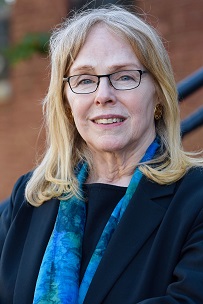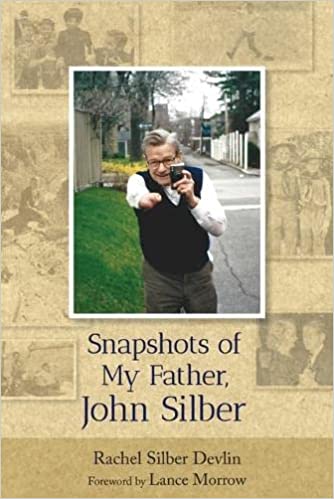On Writing Snapshots of My Father, John Silber : Finding a Vector Into an Immense Life Story
On Writing Snapshots of My Father, John Silber :
Finding a Vector Into an Immense Life Story
By Rachel Silber Devlin
 How can I write a biography of the man, John Silber, who was larger than life—who was on the planning committee for the commission that created Head Start; who rescued Boston University when it was languishing near bankruptcy and obscurity to infuse it with the energy and will to become a major institution of learning and research; who was a controversial, yet intellectually challenging, candidate for governor of Massachusetts; who many knew as a friend that would help with reasoned advice, or even financial help when needed; who on the other hand had a quicksilver temper that could flare unexpectedly; who was always alive in the moment—never blasé or bored—in fact the most electrifying person to be with?
How can I write a biography of the man, John Silber, who was larger than life—who was on the planning committee for the commission that created Head Start; who rescued Boston University when it was languishing near bankruptcy and obscurity to infuse it with the energy and will to become a major institution of learning and research; who was a controversial, yet intellectually challenging, candidate for governor of Massachusetts; who many knew as a friend that would help with reasoned advice, or even financial help when needed; who on the other hand had a quicksilver temper that could flare unexpectedly; who was always alive in the moment—never blasé or bored—in fact the most electrifying person to be with?
These were the questions that assailed me when people who knew my father, my Pop, told me I should write about him. A complete biography of his life and his interests would require years of research and several volumes. The task was too daunting. Where could I begin?
This quandary continued to plague me for a few years after my father died, until I realized I didn’t need to try to write the whole chronological story. Instead, I could pierce the shell of this unfathomable subject and pull out aspects of my father, facet by facet—hoping to create an authentic picture of him by presenting true impressions of his many parts. I felt that I was circling my father, striving with each chapter to approach him from another angle—trying my best to bring him to life.
Naturally, this is a loving portrait, but to me, it would be useless, if it were not also clear-eyed and truthful. A phony idol was of no interest to me.
The first chapter of the book, and the first chapter I wrote, is about my maternal grandmother, my father’s mother-in-law, so often a dread figure in men’s lives, but someone Pop admired, and with whom he had a special relationship. He admired the way she created a beautiful life out of so little during the Depression, and he modeled the way my siblings and I were raised on her example. Whenever we traveled, we did it her way, taking along air mattresses so we could camp out in one hotel room—a great saving when you have seven children. That way we were able to travel a great deal, back and forth across the country regularly, and around Europe, as well.
Once I had the first chapter on paper, the rest of the book began to take shape in my mind in three distinct parts. Because my father was an artist, I thought of the parts in terms of an artwork. In the Background, I go into the formative years and early influences; in the Foreground I look at my mother, my siblings, and me, and Pop’s trajectory from Texas to Boston University and what life became like there, including his run for governor of Massachusetts; and in the Patina I describe the later years, the hardships he weathered, and his continued accomplishments while out of the public eye. As works of art take on an extra richness as they age, so did Pop’s character take on a mantle of valor and validity as he was severely tested by debility and fate.
Because of the method I used to write this book, plumbing the depths of my father’s life in different areas, each chapter can easily stand alone. So it is fine if a reader wants to jump ahead and read a particular part, such as the chapter on the behind-the-scenes goings-on in the race for governor of Massachusetts in 1990. However, I believe I also succeeded in building an understanding, from each chapter to the next, and then to my conclusion, so that the book is an effective and valid whole. Therefore it is worthwhile to read it from beginning to end, and I hope most readers will do so.
I called the book Snapshots of My Father, John Silber, because, as the title implies, each chapter is like a snapshot taken from my perspective, peering into the past I saw. Nevertheless, I do not believe these are merely superficial glimpses. As old photographs reveal details that become apparent as you gaze at them and study them, working on each chapter brought forward long-forgotten details and pointers.
When I told people I was writing a book about my dad, they often had John Silber stories of their own to tell me. And when I let my five sisters read the manuscript, they all had memories to add, and their memories sparked more recollections of my own, making the text richer.
When I was ready to work on the pictures to illustrate the book, Covid happened and I got delayed by a year and a half. But when things started to open up again, Boston University Photography allowed me to look through their extensive picture files. I also had all of the Silber family photographs. There were so many great shots that in the end it was difficult to pare down the number to about two hundred. Then I focused on doing a thorough job of captioning the photos, making sure it was clear what was going on in each picture and who the people were, as well as adding my own comments.
In all it took about seven years to complete the book. When I got started, I did not expect it to take so long, but I am glad it did because I learned so much along the way, and the book is richer for it.
—
Author Rachel Silber Devlin is one of John Silber’s seven children. As a wife, mother, teacher and writer, she has always had a strong sense of who she was apart from any labels. Devlin says that she sometimes feels like she and her dad grew up together because she knew him so well from a time when he was young and still learning how to make his way in the world. She divides her time between her homes in Texas and Massachusetts, the states where her children and grandchildren live.
About the Book:
 Snapshots of My Father, John Silber is a candid and extensively illustrated biography of John Silber, who entirely transformed Boston University as its president and was a controversial, yet intellectually formidable, candidate for governor of Massachusetts. In this book, Rachel Silber Devlin looks at her family and her father’s trajectory from Texas to Boston and what life became like there; she examines his personality and temperament; and she describes his later years, the hardships he weathered and his continued accomplishments out of the public eye.
Snapshots of My Father, John Silber is a candid and extensively illustrated biography of John Silber, who entirely transformed Boston University as its president and was a controversial, yet intellectually formidable, candidate for governor of Massachusetts. In this book, Rachel Silber Devlin looks at her family and her father’s trajectory from Texas to Boston and what life became like there; she examines his personality and temperament; and she describes his later years, the hardships he weathered and his continued accomplishments out of the public eye.
Devlin chose to tell her father’s story because John Silber is so controversial and widely misunderstood. People who knew him either loved him or hated him. Each chapter is like a snapshot taken from a daughter’s perspective, peering into the past she saw.
Silber championed freedom of speech, believing all sides should be heard, especially on college campuses. He was also the father of seven children. Snapshots of My Father is a clear-eyed vision of this authentic man of principle who had a drive to achieve great things.
BUY HERE
Category: On Writing

























